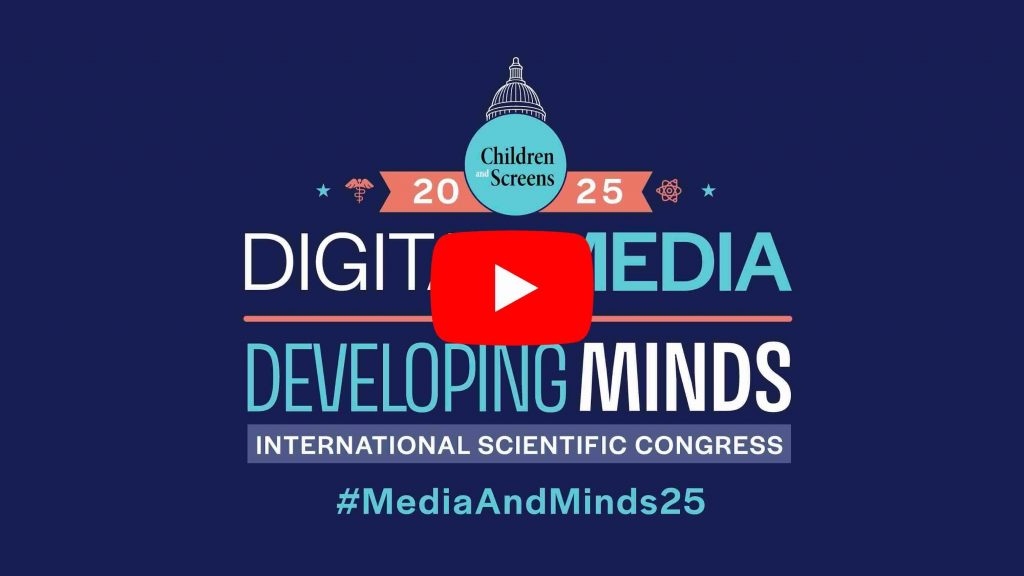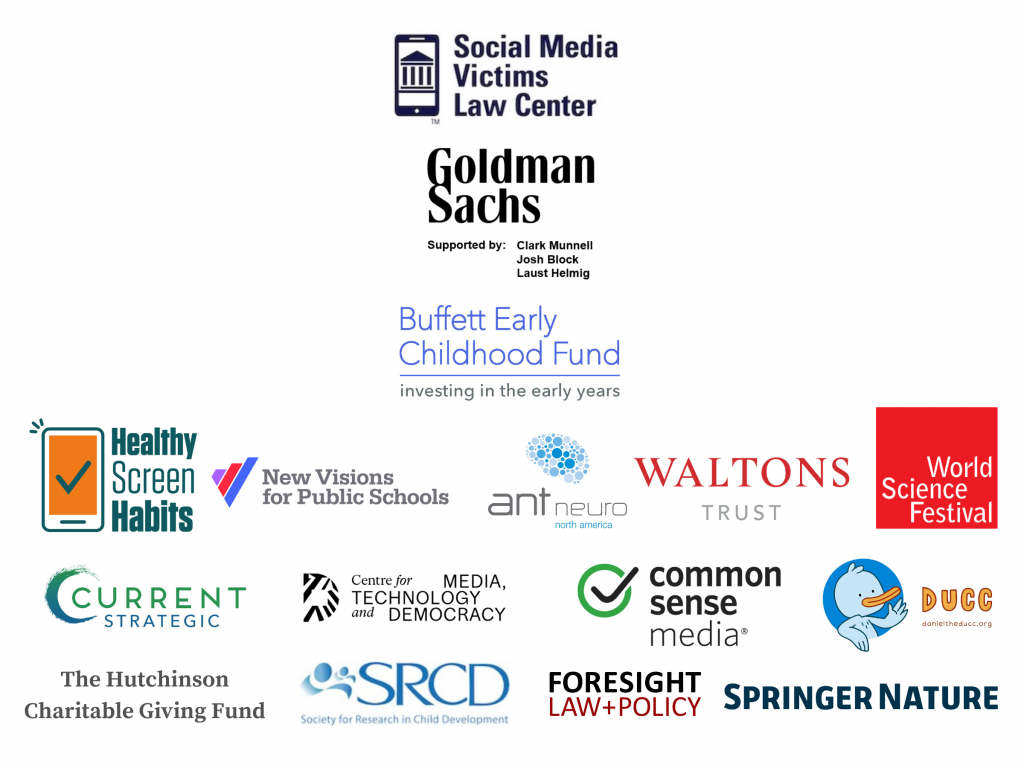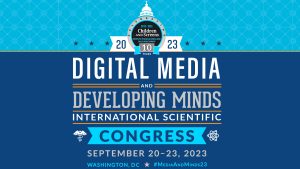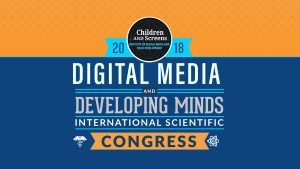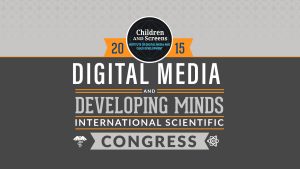2025 Digital Media and Developing Minds International Scientific Congress
2025 digital media and developing minds international scientific congress
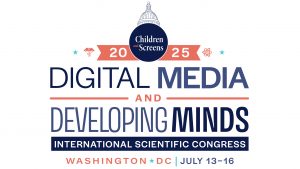
The 2025 Digital Media and Developing Minds International Scientific Congress was an interdisciplinary convening that brought together researchers, clinicians, educators, government agency representatives, and others with expertise in child development, psychology, psychiatry, neuroscience, pediatrics, communications, social work, public health, education, human-computer interaction and more to explore how digital media use impacts the social, psychological, cognitive, behavioral, and physical development of children and adolescents.
This four-day conference was held at the Westin Downtown, 999 9th Street, NW, Washington, D.C. and featured a variety of events, including featured keynotes, interdisciplinary panel discussions, new research presentations, flash talks, a Tools and Methodologies Exposition, poster sessions, and networking opportunities.
Key Takeaways
Children and Screens convened the 2025 Digital Media and Developing Minds International Scientific Congress in Washington, DC, bringing together hundreds of researchers, clinicians, educators, policymakers, and advocates. Over four days, participants engaged with cutting-edge research, explored complex questions, debated critical issues, and collaborated on bold solutions to advance children’s well-being in an increasingly digital world.
From AI and novel measurement tools to online safety, global health equity, U.S. policy strategies, and the nuances of parent-child dynamics, this year’s Congress pushed the field to think more deeply—and more urgently—about what it will take to protect children’s well-being in a rapidly-advancing tech landscape.
Insights and Imperatives:
We know more than ever about how digital media impacts youth.
While open questions remain, the evidence is clear: digital experiences shape children’s development in both positive and negative ways. Overstating the idea that “The science is unclear” can create confusion and delay meaningful action. In reality, today’s research is more rigorous, more diverse, and more applicable than ever and it should be used to guide decisions that protect and support children in the digital age.
Digital media poses real risks, but also real benefits.
The effects of screen use are complex. While certain platforms and features—like algorithmically-guided social media or financially coercive games—pose clear risks, others offer opportunities for connection, learning, and joy. Further research, policies, and intervention should reflect this nuance.
It’s time to shift the burden upstream.
Families play a critical role in guiding children’s digital lives, but they cannot be expected to carry this burden alone. The underlying risks to children are baked into platform design and business models. Speakers underscored the need for upstream solutions, including policy reform, platform accountability, and structural safeguards that proactively address the risks embedded in business models and design, rather than treated as an afterthought.
Today’s engagement-maximizing digital platforms are not designed with children’s developmental needs in mind. The result is a digital ecosystem that introduces risk and fails to support flourishing. Yet, it’s not too late to course-correct. Together, we can establish new norms that prioritize healthy development and advocate for policies that hold technology developers accountable while preserving a free and fair internet. The science presented at #MediaAndMinds25 must be at the forefront of this shift.
Open, collaborative dialogue is essential.
We have a responsibility to create space for honest, shame-free conversations about how technology is being used by children and families across home, school, clinical, and community settings. Solutions should be co-designed with those most affected, including youth, parents, and caregivers, keeping in mind that adults and child-development experts must responsibly scaffold youth and protect child safety online just as they do in every other domain of development.
We must invest in alternatives.
Greater investment is needed in healthier platforms, better-designed tools, and the broader eco-system that contributes to child well-being, such as safe community spaces, and parental mental health.
We should broaden our perspective.
Children’s digital experiences are shaped by intersecting systems, which include families, schools, cultures, economies, and histories. Research, education, and interventions must reflect this complexity without overwhelming those they mean to support.
A more global and inclusive evidence base is also urgently needed to avoid a one-size-fits-all solution rooted in English-speaking, Western, and middle-class contexts. While many insights about the digital landscape for children are general and may be broadly applied, solutions that ignore this complexity risk causing harm elsewhere.
Messaging needs to be disciplined, clear, and audience-aware.
The science is clear: digital media affects child health and development. While research is ongoing, the field should strive to speak with greater clarity and unity. Public messaging should be grounded in evidence, consistent across disciplines, and strategically framed to resonate with diverse stakeholders – from caregivers and clinicians to tech leaders and lawmakers. Messaging should inform and empower, not shame.
Science should lead – but it needs support.
As digital policy and product design evolve at an unprecedented speed, science needs to keep pace. Researchers at #MediaAndMinds25 highlighted key barriers to progress, including the rising costs of collecting diverse, representative data and limited access to platform-held datasets. They underscored the need for greater investment, streamlined data-sharing mechanisms, and ongoing opportunities for cross-sector collaborations. Advancing innovative research methods will be essential to keep up with rapid, technological change. While innovation may always outpace research, more agile and purposeful scientific inquiry can narrow the gap and inform responsible innovation.
Watch Snapshot Videos
Congress Planning Committee
The 2025 Congress was made possible by the guidance of Children and Screens’ founder and members of the Institute’s National Scientific Advisory Board. Their combined expertise helped shape the Congress’s programming to best reflect the event’s goal of bringing together interdisciplinary experts to explore how digital media use impacts the social, psychological, cognitive, behavioral, and physical development of children and adolescents.
- Dimitri Christakis, MD, MPH
Seattle Children’s Hospital, University of Washington, JAMA Pediatrics, Special Olympics, Children and Screens: Institute of Digital Media and Child Development - Lauren Hale, PhD
Stony Brook University - Pam Hurst-Della Pietra, DO
Children and Screens: Institute of Digital Media and Child Development, Stony Brook University - Heather Kirkorian, PhD
University of Wisconsin-Madison - Marc Potenza, MD, PhD
Yale School of Medicine - Stephanie Reich, PhD
University of California, Irvine - Desmond Upton Patton, PhD
University of Pennsylvania - Ellen Wartella, PhD
Northwestern University - Paul Weigle, MD
Hartford Hospital, American Academy of Child and Adolescent Psychiatry
Location and Housing
 The 2025 Digital Media and Developing Minds International Scientific Congress took place at the Westin DC Downtown, in the heart of the city.
The 2025 Digital Media and Developing Minds International Scientific Congress took place at the Westin DC Downtown, in the heart of the city.
The Westin DC Downtown
999 9th Street, NW, Washington, DC, 20001
There are two Westin hotels in the Washington, DC, area. The 2025 International Scientific Congress took place at The Westin DC Downtown, located at 999 9th Street NW, Washington, DC, 20001.
Please see the FAQ page for additional information and directions.
